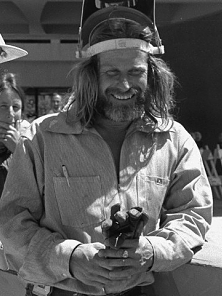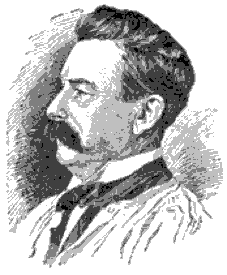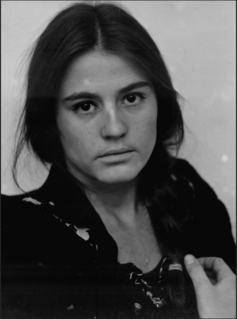
Nam June Paik was a Korean American artist. He worked with a variety of media and is considered to be the founder of video art. He is credited with the first use (1974) of the term "electronic super highway" to describe the future of telecommunications.

Malvina Cornell Hoffman was an American sculptor and author, well known for her life-size bronze sculptures of people. She also worked in plaster and marble. Hoffman created portrait busts of working-class people and significant individuals. She was particularly known for her sculptures of dancers, such as Anna Pavlova. Her sculptures of culturally diverse people, entitled "Hall of the Races of Mankind", was a popular permanent exhibition at the Field Museum of Natural History in Chicago. It was featured at the Century of Progress International Exposition at the Chicago World's Fair of 1933.

William Zorach was an American sculptor, painter, printmaker, and writer. He won the Logan Medal of the arts. He is notable for being at the forefront of American artists embracing cubism, as well as for his sculpture.

Alexander Ney is an American sculptor and painter. After establishing himself in 1972 as a resident of France, he immigrated to the United States in 1974 and has since lived and worked in New York City. Developing several individualistic styles in modern art, he is most famous for his unique work in terra cotta sculpture, involving heavily perforated surfaces and intriguing forms.

Tel Aviv Museum of Art is an art museum in Tel Aviv, Israel. The museum is dedicated to the preservation and display of modern and contemporary art from Israel and around the world.

The J. Paul Getty Museum, commonly referred to as the Getty, is an art museum in Los Angeles, California housed on two campuses: the Getty Center and Getty Villa.

Richard Howard Hunt is one of the most important sculptors of the 20th century. In the second half of the 20th century, he became "the foremost African-American abstract sculptor and artist of public sculpture." Hunt, the descendant of enslaved people brought through the port of Savannah from West Africa, studied at the School of the Art Institute of Chicago in the 1950s, and while there received multiple prizes for his work. He was the first African American sculptor to have a retrospective at Museum of Modern Art in 1971. Hunt has created over 160 public sculpture commissions in prominent locations in 24 states across the United States, more than any other sculptor. With a career that spans seven decades, Hunt has held over 150 solo exhibitions and is represented in more than 100 public museums across the globe from California to Maine, Detroit to Birmingham, and Vienna to Jerusalem. Hunt has served on the Smithsonian Institution's National Board of Directors. Hunt's abstract, modern and contemporary sculpture work is notable for its presence in exhibitions and public displays as early as the 1950s, despite social pressures for the obstruction of African-American art at the time. Naomi Beckwith, Deputy Director and Jennifer and David Stockman Chief Curator of the Solomon R. Guggenheim Museum declared Richard Hunt "One of the most innovative artists of the Twentieth Century." President Barack Obama has stated "Richard Hunt is one of the greatest artists Chicago has ever produced."

Chaim Gross was an American sculptor and educator of Ukrainian Jewish origin.

Marco Polo "Mark" di Suvero is an abstract expressionist sculptor and 2010 National Medal of Arts recipient.

Herbert Ferber was an American Abstract Expressionist, sculptor and painter, and a "driving force of the New York School."
Bryan Hunt is an American sculptor who was born in Terre Haute, Indiana on June 7, 1947. His family moved to Tampa, Florida in 1955. He worked at the Kennedy Space Center as an engineer's aide and draftsman, 1967–1968, during the NASA Apollo Program. In 1968, he moved to Los Angeles to enroll in the Otis Art Institute, where he received a BFA in 1971.

Chryssa Vardea-Mavromichali was a Greek American artist who worked in a wide variety of media. An American art pioneer in light art and luminist sculpture, known for her neon, steel, aluminum and acrylic glass installations, she always used the mononym Chryssa professionally. She worked from the mid-1950s in New York City studios and worked since 1992 in the studio she established in Neos Kosmos, Athens, Greece.

The Getty Center, in Los Angeles, California, is a campus of the Getty Museum and other programs of the Getty Trust. The $1.3 billion center opened to the public on December 16, 1997 and is well known for its architecture, gardens, and views overlooking Los Angeles. The center sits atop a hill connected to a visitors' parking garage at the bottom of the hill by a three-car, cable-pulled hovertrain people mover.
Sculptors Guild, a society of sculptors who banded together to promote public interest in contemporary sculpture, was founded in 1937. Signatories to the original corporation papers were Sonia Gordon Brown, Berta Margoulies, Aaron Goodelman, Chaim Gross, Minna Harkavy, Milton Horn, Concetta Scaravaglione, Warren Wheelock, and William Zorach. The inaugural exhibit of the Guild was held April 12 - May 31, 1938, on a vacant lot at Park Avenue and 39th St. This outdoor exhibit, the first of its kind in New York City, hosted 40,000 visitors paying an admission price of ten cents to view the work. Owing to the tremendous success of this first exhibit, the Brooklyn Museum held an exhibit of contemporary American sculpture by Guild members, October 21- November 27, 1938.

Eli Harvey was an American sculptor, painter and animalier.

George Herms is an American artist best known for creating assemblages out of discarded, often rusty, dirty or broken every-day objects, and juxtaposing those objects so as to infuse them with poetry, humor and meaning. He is also known for his works on paper, including works with ink, collage, drawing, paint and poetry. The prolific Herms has also created theater pieces, about which he has said, "I treat it as a Joseph Cornell box big enough that you can walk around in. It's just a continuation of my sculpture, one year at a time." Legendary curator Walter Hopps, who met Herms in 1956, "placed Herms on a dazzling continuum of assemblage artists that includes Pablo Picasso, Kurt Schwitters, Marcel Duchamp, and Joseph Cornell, as well as California luminaries Wallace Berman and Edward Kienholz." Often called a member of the West Coast Beat movement, Herms said that Wallace Berman taught him that "any object, even a mundane cast-off, could be of great interest if contextualized properly." "That’s my whole thing," Herms says. "I turn shit into gold. I just really want to see something I've never seen before." George Herms lives and works in Los Angeles.

Roberto Chavez is an American artist. known for his personally symbolic portraits, public murals and "funny-grotesque" paintings that reflect the multicultural landscape of Los Angeles. He was recently included in the Getty Center's Pacific Standard Time: Art in L.A., 1945-1980 and the Smithsonian’s Our America: The Latino Presence in American Art exhibits.

Marja Vallila was an American artist, painter, ceramicist and sculptor.
Sonata Primitive is a copper 1940–1948 sculpture by Saul Baizerman, installed in the San Diego Museum of Art's May S. Marcy Sculpture Garden, in the U.S. state of California.

Eugenie Baizerman (1899–1949) was an American artist.
















